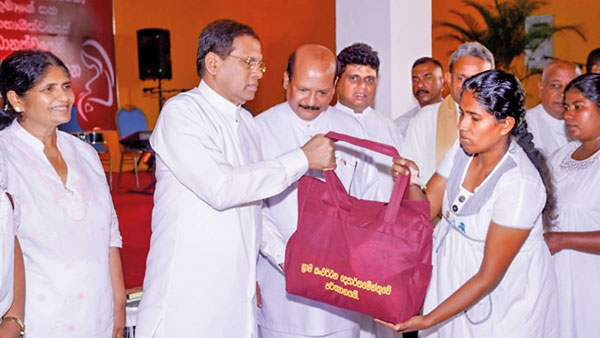Sunday Times 2
The problem begins in the womb: Sri Lanka’s nutrition gains at risk
View(s):By Dr Ruben Thurairajah
In the late 1980s, British doctor David Barker startled the medical world with a simple claim: the illnesses we face in adulthood often begin in the womb. Babies born small or undernourished, he showed, carried higher risks of heart disease, high blood pressure and diabetes decades later. Low birth weight, Dr Barker argued, was not just a short-term problem; it was a lifelong sentence. In many countries, it is a punishment for being born into poverty.
A quiet success story
Sri Lanka was quicker than most countries to act on such insights, even before Dr Barker gave them scientific weight. For decades, our health services built a strong foundation in maternal and child care. Antenatal clinics spread across the island, midwives became trusted household figures, and breastfeeding was vigorously protected. And encouraged.
One emblem of this success was Thriposha, launched in 1973 with the support of CARE, an international humanitarian charity. At first, it was a donor-funded supplement, a simple mixture of maize and soy fortified with vitamins and minerals. But it grew into a national programme, produced locally and distributed to pregnant women and young children.
“We used to remind mothers: one packet of Thriposha is as important as your clinic card,” recalls a retired public health midwife from Varikuttiuruwa. “It wasn’t just food. It was a symbol of care.”
The results were striking. Infant and maternal nutrition indicators steadily improved, and Sri Lanka earned praise as a rare low-income country that outperformed its neighbours. While challenges remained, the country stood out in South Asia for lowering low birth weight rates and keeping childhood stunting well below regional averages.

Pregnant mothers being given nutrition packs by then President Maithripala Sirisena under a programme that underscored successive government’s commitment to ensuring maternal and child care
Barker’s warning, confirmed here
Local research has since validated Dr Barker’s hypothesis. Sri Lankan studies show that adults who were born underweight are more likely to develop hypertension and cardiovascular disease. “We see it in our wards every day,” says a cardiologist at the National Hospital. “Patients in their forties who were born small are now arriving with high blood pressure and heart disease. The link is undeniable.”
Every gram of weight gained in the womb, every fortified meal given to a pregnant mother, becomes an investment in the long-term health of the nation.
The crisis that changed the equation
But all this progress is under severe threat. The recent economic crisis shook households to the core. Food inflation spiralled. Milk, eggs, and fish slipped out of reach for many families. Pregnant women cut down on meals, and young children were fed thinner porridges.
“I used to buy milk powder for my two children every week,” says Shanthi, a garment worker from Negombo. “Now I can only afford one packet a month. Sometimes I mix it with extra water so it lasts longer. What else can I do?”
At the same time, programmes like Thriposha faced disruptions in production and distribution. When a nation is struggling to find dollars for medicine imports, fortified food supplements inevitably suffer. Families that once took state support for granted suddenly find themselves without the safety nets that had held firm for half a century. Last year 665 thousand mothers and almost a million children received Thriposha packets.
The double danger
The immediate consequence is obvious: hunger, wasting, and anaemia among mothers and children. But the deeper danger is less visible. A child born undernourished and underweight in 2025 may not show ill effects now, but by the 2070s that child may be part of a generation more vulnerable to heart attacks, strokes, and diabetes.
“The children we fail to nourish today will fill our hospital beds tomorrow,” warns a paediatrician in Kandy. “This is the hidden cost of the crisis.”
What must be done
The path forward is clear, if not always easy.
- Protect maternal nutrition above all. Pregnant and lactating women must have access to adequate calories, protein and micronutrients.
- Safeguard Thriposha. However modest, it has been a cornerstone of Sri Lanka’s nutrition policy. Its steady supply must be guaranteed even in times of financial strain.
- Monitor birth weight and child growth. Routine tracking can serve as an early warning system, alerting policymakers to rising risks before they become entrenched.
- Target the most vulnerable. People who live and work in tea estates and poorer households in other areas still face the highest burden of low birth weight. They must be prioritised in every nutrition response.
A fragile achievement
Sri Lanka has long punched above its economic weight in health. Visitors from across Asia and Africa have studied our maternal and child health system with admiration. But this achievement is fragile. One deep economic crisis is enough to reverse decades of hard-won progress.
Dr Barker’s insight remains as relevant today as when he first proposed it: the unborn child carries the memory of its mother’s hardship. If we fail to protect mothers and infants now, the cost will not only be seen in today’s malnourished children but also in the heart disease wards of the future.
Sri Lanka has shown before that it can protect its most vulnerable even in difficult times. The challenge now is to remember that lesson and to act before today’s crisis becomes tomorrow’s epidemic.

